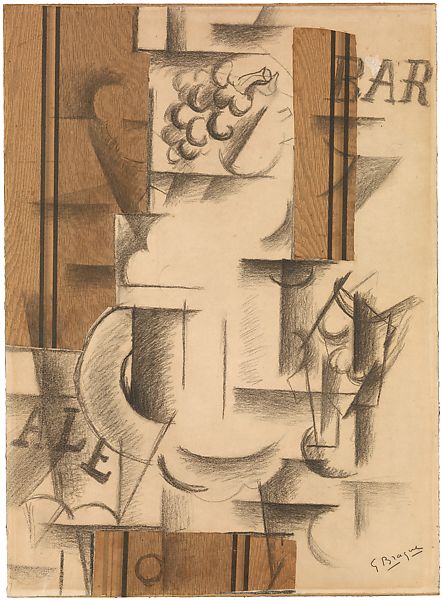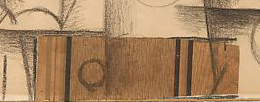Synthetic Cubism, Part I
by DR. CHARLES CRAMER and DR. KIM GRANT[1]
Starting in 1912, surprising new elements begin to turn up in works by Pablo Picasso and Georges Braque: cut-up pieces of newspaper, wallpaper, construction paper, cloth, and even rope. Although the resulting collages are visually very different from the largely monochromatic oil paintings most commonly associated with the movement, they are still considered to be part of Cubism.
Partly this is because these works often included drawings that use techniques associated with Cubism, such as deconstructing objects into fragmented, angular forms seen from multiple perspectives. Beyond this similarity, though, there is also another, more conceptual one. This new phase of Cubism is also dedicated to exploring the ambiguities of representation, now on an even wider scale.

Fruit Dish and Glass is Braque’s first work using papier collé (pasted paper), a subset of collage made using only paper. Picasso’s first collage, Still Life with Chair Caning preceded Braque’s Fruit Dish and Glass by a few months and was made from a variety of materials including oilcloth and rope. Papier collé was a central medium in the second phase of Braque’s and Picasso’s joint Cubist investigations commonly known as Synthetic Cubism.
Retreat from abstraction
During this phase both artists retreated from the verge of total abstraction they had reached in their late Analytic Cubist paintings. Synthetic Cubist works use multiple forms of representation, combining the abstracted forms of Analytic Cubism with color, collage, and even sometimes naturalistic representations, to create a complex whole.

In Fruit Dish and Glass, Braque combines Cubist drawing with illusionistic representation, words, and decorative paper printed with a wood grain pattern (faux bois). At the top we see a bunch of grapes drawn relatively naturalistically, with light and shade defining its three-dimensional forms. The remaining still-life objects are depicted in an Analytic Cubist style that deconstructs them into arcs, cylinders, and flat planes representing a fruit dish, plates, and glasses on a table. The words “BAR” and “ALE” are frequently seen on signs and labels in cafés and indicate the general location of the still life.
References to traditional illusionism

Charcoal drawing extends over the strips of wood grain paper that frame and anchor the central forms. The two vertical strips in the upper portion represent wood paneling on a café wall behind the still life, while the horizontal strip below represents a wooden table supporting the dishes and fruit. A circle drawn on the lower strip of wood grain paper suggests the round knob of a drawer pull. This is a reference to illusionistic paintings, which often depict handles and knobs facing the viewer to enhance the sense of the objects being real and within easy reach.
A kind of certainty
Braque later wrote:
The papiers collés in my drawings have also given me a kind of certainty.[2]
This is generally understood to mean that they allowed him a way to retreat from the increasingly unmoored abstraction of late Analytic Cubism and anchor his works more solidly in relation to reality. The vaporous spaces and ambiguous forms of Analytic Cubist paintings like The Portuguese are, however, replaced by a different type of ambiguity resulting from the complex and shifting relationships of disparate materials and modes of signification.
Braque’s association of papiers collés with certainty should also be understood in terms of literalism and materiality. Picasso and Braque often employed collage elements as a shortcut means to represent objects. A newspaper in a still life of a café table will be represented by simply gluing newspaper to the picture plane, rather than painstakingly imitating its appearance using paint. Similarly, literal wallpaper is used to represent the presence of wallpaper in the scene, and the actual label is used to show a label on a bottle of wine. This is a form of playful one-upmanship of the Western tradition of naturalistic depiction: the artist now offers reality itself, rather than illusion.

In Siphon, Glass, Newspaper and Violin, Picasso displays the multiple ways charcoal drawing and papier collé can be used to represent objects. For example, on the left newspaper is cut into the shape of a siphon, while on the right it is used as a surface for drawings of a glass and part of a violin. Its edges also define the left side of the violin’s upper body and neck.
Papier collé and collage not only anchored Cubist forms more firmly as distinct material objects, they also gave the artists a particularly rich means for generating multiple possibilities of meaning through a combination of media, representational strategies, and suggestive shapes and their formal relationships. Collage shapes, materials, colors, and words all contribute to the complex significations that proliferate in Synthetic Cubism.
Additional resources:
Read about Fruit Dish and Glass at the Metropolitan Museum of Art

